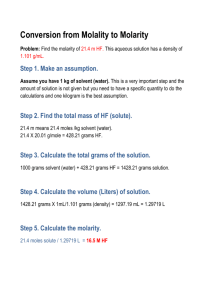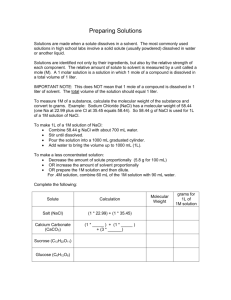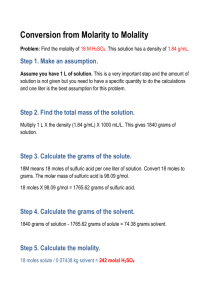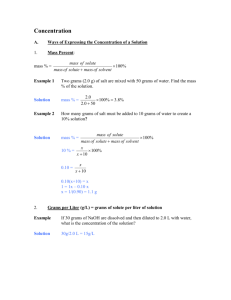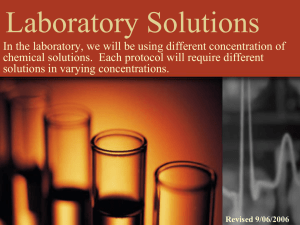Making Solutions Mass Percent
advertisement
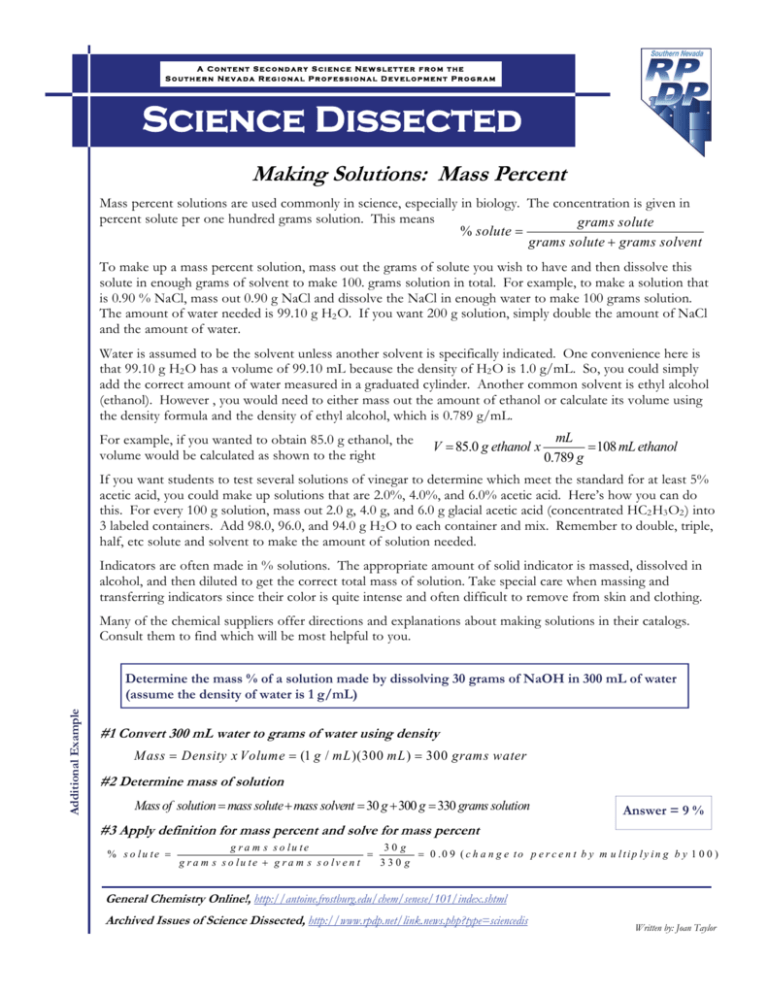
A Content Secondary Science Newsletter from the Southern Nevada Regional Professional Development Program Science Dissected Making Solutions: Mass Percent Mass percent solutions are used commonly in science, especially in biology. The concentration is given in percent solute per one hundred grams solution. This means gramssolute %solute gramssolute gramssolvent To make up a mass percent solution, mass out the grams of solute you wish to have and then dissolve this solute in enough grams of solvent to make 100. grams solution in total. For example, to make a solution that is 0.90 % NaCl, mass out 0.90 g NaCl and dissolve the NaCl in enough water to make 100 grams solution. The amount of water needed is 99.10 g H2 O. If you want 200 g solution, simply double the amount of NaCl and the amount of water. Water is assumed to be the solvent unless another solvent is specifically indicated. One convenience here is that 99.10 g H2 O has a volume of 99.10 mL because the density of H2 O is 1.0 g/mL. So, you could simply add the correct amount of water measured in a graduated cylinder. Another common solvent is ethyl alcohol (ethanol). However , you would need to either mass out the amount of ethanol or calculate its volume using the density formula and the density of ethyl alcohol, which is 0.789 g/mL. For example, if you wanted to obtain 85.0 g ethanol, the volume would be calculated as shown to the right V 85.0gethanolx mL 108mLethanol 0.789g If you want students to test several solutions of vinegar to determine which meet the standard for at least 5% acetic acid, you could make up solutions that are 2.0%, 4.0%, and 6.0% acetic acid. Here’s how you can do this. For every 100 g solution, mass out 2.0 g, 4.0 g, and 6.0 g glacial acetic acid (concentrated HC2 H3 O2 ) into 3 labeled containers. Add 98.0, 96.0, and 94.0 g H2 O to each container and mix. Remember to double, triple, half, etc solute and solvent to make the amount of solution needed. Indicators are often made in % solutions. The appropriate amount of solid indicator is massed, dissolved in alcohol, and then diluted to get the correct total mass of solution. Take special care when massing and transferring indicators since their color is quite intense and often difficult to remove from skin and clothing. Many of the chemical suppliers offer directions and explanations about making solutions in their catalogs. Consult them to find which will be most helpful to you. Additional Example Determine the mass % of a solution made by dissolving 30 grams of NaOH in 300 mL of water (assume the density of water is 1 g/mL) #1 Convert 300 mL water to grams of water using density Mass Density x Volume (1 g / mL )(300mL ) 300 grams water #2 Determine mass of solution Massof solution masssolute masssolvent 30g 300g 330gramssolution Answer = 9 % #3 Apply definition for mass percent and solve for mass percent % s o lu te g r a m s s o lu te 30 g 0 . 0 9 ( c h a n g e t o p e r c e n t b y m u l t i p l y i n g b y 1 0 0 ) g r a m s s o lu te g r a m s s o lv e n t 330 g General Chemistry Online!, http://antoine.frostburg.edu/chem/senese/101/index.shtml Archived Issues of Science Dissected, http://www.rpdp.net/link.news.php?type=sciencedis Written by: Joan Taylor

